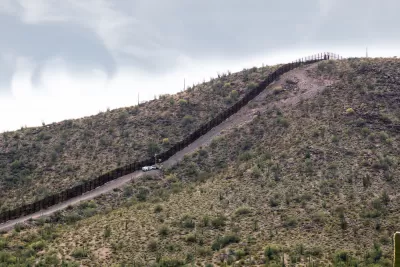William H. Frey, a demographer with Brookings, argues that racial diversity is a good thing for the country by many measures. Trump's wall would make it harder to benefit from demographic changes, but changes is still coming.

"President Trump’s obsession with building a wall along the United States-Mexican border reached its apex today [Feb. 15], with his declaration of a national emergency to pre-empt an 'invasion' of immigrants from Latin America," writes William H. Frey, an internationally regarded demographer with the Brookings Metropolitan Policy Program.
The president’s obsession with the wall amplifies his message to supporters that he is protecting America from rising racial diversity in the U.S. It is the same theme that underlies his Muslim Ban ... and his attempt to undercount immigrants in the 2020 census. Since the early days of his campaign, “The Wall” has encapsulated his message that to make America great, he will keep America white.
Frey's two main points are that with or without secured borders, racial diversity will increase, and that it's good for America.
We are a country that is in the midst of what I have termed a “Diversity Explosion” that is occurring just in time to counter an aging mostly white population—a boom that will keep the nation invigorated and connected with an increasingly global economy. If we are to continue to thrive, America’s leaders need to embrace the diverse nature of this demographic change rather than use it as a wedge issue.
America's population growth for the fiscal year ending July 2018 was 0.62 percent, an 80-year low, according to Census data. In California, the rate was below the national average, only 0.40 percent, though the state data showed a higher rate. Among the white population, two measurements are notable, observes Frey.
- Since 2000, the nation’s white population has grown by just about 1 percent and has actually declined slightly since 2015.
- At the same time, the existing white population will age rapidly as more of the large baby boom generation advances into seniorhood. In other words, within the white population alone, the nation is facing a high level of age dependency.
By contrast, "racial minorities—especially 'new minorities' [Hispanics, Asians, and persons of two or more races]—are younger and their population is growing rapidly," adds Frey.
Since 2000, [Hispanics, Asians, and persons of two or more races] have grown by rates of 67, 82, and 51 percent respectively—together comprising four-fifths of the total U.S. population growth and all of the growth in the country’s youth.
A wall or travel ban will not stop population growth among minorities, i.e., racial diversity will increase, and it will be dispersed throughout the country, which is a good thing, economically speaking.
Between 2010 and 2017, natural increase (the excess of births over deaths) rather than immigration accounted for 62 percent of the total minority population and 73 percent of the Hispanic population.
The dispersion of minorities will be increasingly important for contributing to the growth of prime-aged labor force populations in broad swaths of the country that are experiencing losses of white youth and the retirement of baby boomers.
President Trump is quick to claim credit for the nation's job growth, yet his immigration policies work against filling those jobs. On Feb. 12, the U.S. Bureau of Labor Statistics reported a record amount of job openings in December, jumping 2.4 percent to 7.3 million, exactly one million more than the number of unemployed Americans.
Frey ends his piece with a plea to the nation's leaders to "call on the citizenry, of all ages and backgrounds, to embrace and buy into this change" in order to benefit from growing racial diversity. They need to stress two points:
- This involves both valuing and investing in our racially diverse families and youth—their education, their health, their housing and the like.
- It involves emphasizing the generational co-dependency that exists between today’s mostly white older generation and the diverse younger generations as the latter generations contribute to America’s economic wellbeing and to the former generation’s Social Security and Medicare funding.
Declaring a national emergency to build a border wall is entirely self-defeating, concludes Frey.
FULL STORY: Trump’s wall will not prevent America’s diversity boom

Alabama: Trump Terminates Settlements for Black Communities Harmed By Raw Sewage
Trump deemed the landmark civil rights agreement “illegal DEI and environmental justice policy.”

Study: Maui’s Plan to Convert Vacation Rentals to Long-Term Housing Could Cause Nearly $1 Billion Economic Loss
The plan would reduce visitor accommodation by 25% resulting in 1,900 jobs lost.

Planetizen Federal Action Tracker
A weekly monitor of how Trump’s orders and actions are impacting planners and planning in America.

Waymo Gets Permission to Map SF’s Market Street
If allowed to operate on the traffic-restricted street, Waymo’s autonomous taxis would have a leg up over ride-hailing competitors — and counter the city’s efforts to grow bike and pedestrian on the thoroughfare.

Parklet Symposium Highlights the Success of Shared Spaces
Parklets got a boost during the Covid-19 pandemic, when the concept was translated to outdoor dining programs that offered restaurants a lifeline during the shutdown.

Federal Homelessness Agency Places Entire Staff on Leave
The U.S. Interagency Council on Homelessness is the only federal agency dedicated to preventing and ending homelessness.
Urban Design for Planners 1: Software Tools
This six-course series explores essential urban design concepts using open source software and equips planners with the tools they need to participate fully in the urban design process.
Planning for Universal Design
Learn the tools for implementing Universal Design in planning regulations.
Caltrans
Smith Gee Studio
Institute for Housing and Urban Development Studies (IHS)
City of Grandview
Harvard GSD Executive Education
Toledo-Lucas County Plan Commissions
Salt Lake City
NYU Wagner Graduate School of Public Service





























